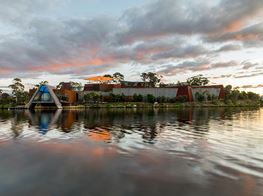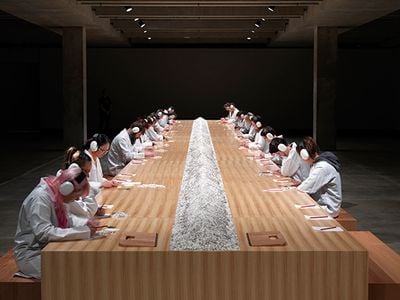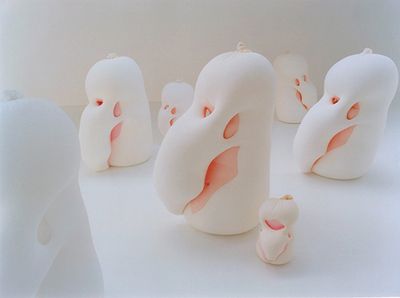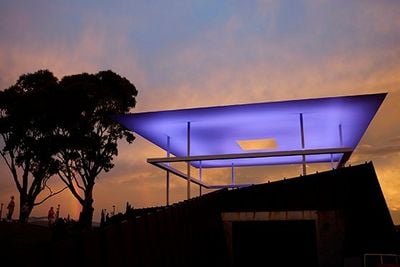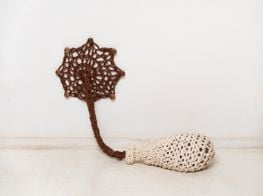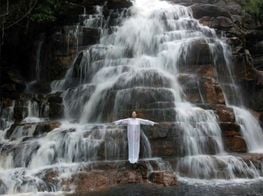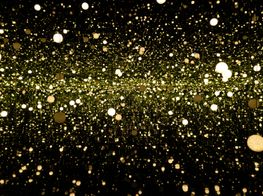Nicole Durling
Nicole Durling, MONA, Senior Curator. Courtesy MONA Museum of Old and New Art, Hobart, Tasmania, Australia. Photo: MONA/Rémi Chauvin.
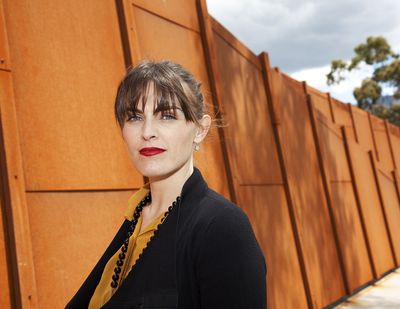
Nicole Durling, MONA, Senior Curator. Courtesy MONA Museum of Old and New Art, Hobart, Tasmania, Australia. Photo: MONA/Rémi Chauvin.
The Museum of Old and New Art (MONA) in Tasmania, Australia is a site of art world pilgrimage and ongoing intrigue. In addition to exhibiting a rotation of works from the collection of its founder David Walsh, and presenting major solo exhibitions of Australian artists and international artists, most recently Cameron Robbins, Mathieu Briand, Gilbert & George, Katthy Cavaliere and Marina Abramović, the private museum operates two major festivals: Mona Foma, or Mofo (as it is also known).
A three-day summer festival presenting a mix of music and art, 'plus food and booze', which for the last nine iterations has been curated by Brian Ritchie of Violent Femmes; and its winter counterpart Dark Mofo, which calls upon its participants to 'celebrate the dark through large-scale public art, food, music, light, film and noise. Across these programmes, the museum emanates a type of 'anti-establishment' ethos approach to contemporary art.
The museum's most recent group exhibition—defined on its website as 'one man's crusade to piss off art academics'—is a case in point. On the Origin of Art (5 November 2016–17 April 2017) aims to look at art without a cultural filter, instead proposing the use of a scientific lens. Four scientists and evolutionary theorists have been invited to curate a segment of the exhibition according to their individual theories on the universal human drivers behind why we make art.
It comprises of 234 objects from 35 countries sourced from MONA's collection and loaned by institutions, and includes nine new commissions by artists and collectives, such as Mat Collishaw and Yayoi Kusama. The exhibition is referred to by Nicole Durling, senior curator of MONA and co-director of exhibitions and collections, as the museum's 'ultimate exhibition' thus far.
Durling joined the museum in 2006, when preliminary designs for the museum's monolithic underground space in Hobart had just started. In this interview, Durling discusses her journey with MONA, and sheds light on how the museum works, discussing past, current and upcoming exhibitions, including On the Origin of Art.
ADYou have been with the museum almost from the start. Could you tell me about the early days?
NDIt was an interesting process to say the least: going through the development of the museum when it was all very much theoretical, and then, after it opened in 2011, actually being part of it in operation. Before we opened, it was very much about establishing who we were and what we wanted to present. It was a lot about juggling the unknown. I certainly didn't have preconceived ideas about what we should be or how we were going to come into being. Part of the development process was to travel and research to see what other museums were doing, or to explore what we found interesting, or not interesting.
ADWas there anything that you remember being particularly influenced by, in terms of what other museums were doing?
NDThere wasn't one thing, but there were parts of many museums, galleries and artist-run spaces that influenced our direction. There were certain idiosyncratic museums that are still influential to this day, like Sir John Soane's Museum in London, which is still one of my favourite spaces and collections. I love going to those types of museums: those very small spaces where you can really get immersed in another world of somebody else's making. There is something slightly strange yet humbling about being allowed into that. MONA and, to use it as an example, Sir John Soane's Museum, are two very different sorts of aesthetic spaces. But I suppose that is what I was drawn to, and what I wanted to flesh out: this idea of being a part of something very generous, but with its own distinct personality.
ADCould you describe any other influences on the museum's direction?
NDWe took our influences then, and still do, from a really broad range of things and experiences—and not just from the arts.
An important factor for MONA is collaboration. We were a really small team right up until the opening, and we came from very varied backgrounds. My background is as a practicing artist and I certainly didn't have, on paper, the credentials to be a part of the museum's foundational team, but there was just something about the way we worked and collaborated together. We started with a solid knowledge base, and fleshed that out, almost instinctually. We aimed to generate something that wasn't overthought.
ADHow would you describe the environment of working in MONA, when you first began?
NDIt was incredibly dynamic, as well as very rigorous in a kind of ad-hoc way. It was also incredibly open; definitely everything was up for grabs, and I think, in a way, that is still true for us today.
ADMany of the exhibitions involve MONA commissioning major works by artists. One example is the exhibition with Australian artist Cameron Robbins, Field Lines (18 May–29August 2016), which involved creating seven site-specific works. There seems to be an element of wanting to push artists beyond their comfort zone.
NDIt was very exciting to see an artist like Cameron Robbins take the bit and just run with it. We want to allow artists the space to take risks and explore. That's my job as a curator: to be mindful of that, to remove the anxieties around exploring something new, and to create a supportive environment around an artist that allows them to take those leaps. But equally, my job is also about getting an artist to stay on track and to deliver something. If it works, great; if it doesn't, oh well—so long as we tried to push as hard as we could.
We want to make exhibitions that are distinct to us and hopefully allow for something unique to develop for the artist, too. Marina Abramović's exhibition, [Private Archaeology (13 June-5 October 2015)], was very MONA and certainly [reflected] her response to us and to our collection as well. It's really important for us to position the artist and their work within a broader narrative of what MONA is.
ADCan you define MONA's narrative?
NDIt's your instinct, your gut feeling. It always puzzles me when people say to me, 'this artist is very MONA', or 'I can just see this in the collection'. I understand where they are coming from, but still it's something that I'm always questioning and second-guessing. When we do something, it's something that I would do this year but it may not be the right thing to do next year. Because once you have explored and tested the ideas, you come out the other end and you are different and have moved on. Everything should be up for grabs. The saying 'no idea is a bad idea' seems apt [laughs] . . . I have had some bad ideas in my time and continue to do so.
I learn so much from working with artists: not just about each individual artist or artists collectively, but also about myself, our staff, about the way we all interact. I always feel, at the end of a project, that I have learnt something new about the world. To have the opportunity to work in a gallery or a museum or anywhere—it doesn't matter what field you're working in—and to be able to learn more is a pretty remarkable thing.
ADDavid Walsh has said, 'some artists can give us a glimmer of things that we usually can't see. Mona delights in such artists.' Can you discuss this?
NDYes. That quote was made in reference to Cameron Robbins. Robbins works in and with the environment: for example, he works with the earth's magnetic anomalies, and more broadly, the outcomes generated on earth as we move around the sun. These are things we exist with every day, but we don't think about them—even though they define who we are and how we go about doing what we do. It encourages us to be aware of what is going on around us.
David Walsh speaks about humans being self-deceiving machines. Fundamentally, every day we have to overcome the consciousness of—or our awareness that—we will die, that we are all mortal. We have to intellectually fight against that reality and it is a type of deception that keeps us going.
ADCould you talk about the On the Origin of Art exhibition?
NDWe have been working on a form of this exhibition since the day MONA opened. Ultimately the underlying questions are the reason why the museum was built.
The exhibition's premise is very much about understanding what art is, or why we—the global we—do what we do. Instead of using a cultural filter to make an exhibition to think about art, write about art or to look at art, we use a biological filter. We propose art as a biological adaptation, much like your thumb. Art is universal, all cultures have done it in one way or another, and arguably even animals do it, depending on what you define 'art' as.
For the exhibition we invited four guest curators who have not really dealt with art before in the art-curatorial sense. Their names are Steven Pinker, Mark Changizi, Brian Boyd, and Geoffrey Miller. They are all academics, and all of their professional investigations revolve around understanding or hypothesising our biological drivers. They have theories around why we do what we do, and why we have evolved to do certain things.
It's difficult for me to deeply understand any of the dense, theoretical, scientific investigations surrounding the exhibition, but it has allowed me to look at art in a different way. It is both confronting and really inspiring to think of something you feel so familiar with in a new manner. Art is something that should always be questioned - 'a shark that doesn't move forward dies', to quote Woody Allen.
The exhibition breaks down a lot of cultural boundaries that exist in the art world. We do like to hide in the familiar, and there's probably a biological reason for that. We like to move in packs and that's how we've evolved: in herds. I don't want to be overtly critical about the art world, but every now and then we should stop patting ourselves on the back and perhaps just say we're actually not that amazing, though there are moments of inspiration. It's something we should be a little bit more open about, in terms of how we look at things. Certainty is not something that we should be specialising in.
With On the Origin of Art, we are making a pretty bold statement and saying that culture is important, but not as important as our biological imperatives that underpin why we do what we do.
ADYou mentioned that you were a practicing artist before you began working for MONA. Do you still make art?
NDNo, I don't still practice. I do spend quality time with my nieces and nephew, teaching them—my field was ceramics. I still have ideas, but I just felt like I'd done everything I wanted to do. I also realised I was setting myself up for a lifetime of solitude, which is not a good thing for an introvert to do. I need to push myself out of my comfort zone and get myself out of my studio nest to shake myself up a little bit.
ADHow do you think previously being a practicing artist impacts how you look at art?
NDOne of the things I cannot stop asking is 'how did you make it?' My brothers are engineers, so maybe it's in my genes. Craftsmanship or technical aptitude is really amazing. But equally, the artist can be incredibly proficient, a master of what they do, but the end result might be boring. Ultimately, I couldn't care less how remarkably engineered an object is, but it does have to possess something that makes it special beyond that.
When someone says, 'my mum could have made that, my kids could have painted that'—well, that's my job to understand why your mum couldn't have made it.
ADWhat's next for Mona?
NDWe've got lots of projects coming online, and site-specific projects under development. The Turrell wing, which is under construction, is due to be finished at the end of 2017, early 2018, so there'll be four Turrell works in there. There is also a plan to install the Richard Wilson 20:50 (1987) installation work, which MONA has acquired.
ADThat was the first work of art I can remember seeing when I moved to London.
NDIt was mine also.
The festivals, of course, are still going strong. We have a commitment to Dark Mofo for the next four or five years, and that's a really exciting opportunity for us to do more projects outside of the museum context.
ADHow much does the museum focus on research and writing?
NDIt's intrinsic. The catalogues or publications that accompany any exhibitions or projects are very important. You'll see that in the catalogue for On the Origin of Art, which is somewhere in the vicinity of 500 pages; it's vast, with lots of beautiful pictures. Books are one of David's biggest loves, and we will be developing a larger library over the next few years. David has been collecting books for a long time.
ADMy understanding is that at MONA, the works are completely unlabelled: there's no text around the images.
NDOur replacement for wall labels is software called the O, which runs off iPhones, iPads and iPods; all the interpretative material is accessible via that, and visitors are encouraged to use it upon entry to the museum.
The O works like a GPS: you walk around the museum, you refresh, it tells you where you are and what artworks are around you. You can save and retrieve your tour if you choose it to be emailed to you. It's a great tool for art teachers. Unlike static wall labels, the audio and texts can develop across the duration of the exhibition.
ADYou have dispelled a myth I've heard about the museum: that there's no text to accompany the work.
NDWe are very committed to artists and their moral rights and ensuring that they are acknowledged. Ultimately they're the ones taking the risks, not the museum.
MONA's all about myths. We create them a little bit ourselves. We made the museum up from scratch, so there was a process of creating personality and identity. David gives good copy, so he's the master at it. But I think people revel in that, because we do also leave a lot of space and gaps for interpretation so people tend to fill them up. —[O]

